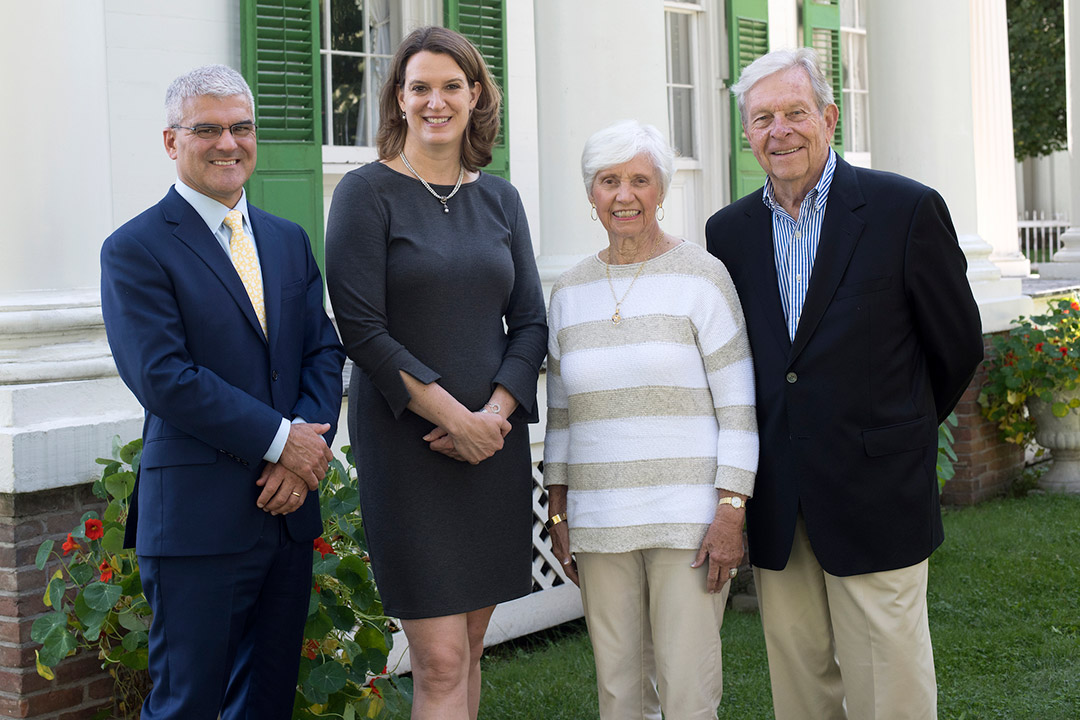RIT and Genesee Country Village & Museum seal partnership with $1.3 million gift
University and museum will collaborate on projects, research and exhibits
A. Sue Weisler
RIT Liberal Arts Dean James Winebrake, left, Genesee Country Village & Museum President and CEO Becky Wehle, and Anne and Phil Wehrheim meet at the museum.
Rochester Institute of Technology has received a $1.3 million gift to endow its partnership between the university and Genesee Country Village & Museum.
The gift comes from RIT alumnus Philip Wehrheim and his wife, Anne. Wehrheim received a degree in business from RIT in 1966.
The gift marries Wehrheim’s interest in both RIT and the museum.
“For me to be able to do this for the museum and also for my alma mater is a perfect fit,” he said.
James Winebrake, dean of the College of Liberal Arts, said that while his college will manage the gift, the fund will support projects involving all colleges at RIT.
“Experiential learning is a hallmark of our university,” Winebrake said. “This gift will guarantee opportunities for our students to gain valuable experience while benefitting the museum and the community for years to come.”
Becky Wehle, president and CEO of the living history museum in Mumford, N.Y., 12 miles southwest of RIT’s Henrietta campus, said she is enthusiastic about the potential the gift holds for both organizations.
“RIT is an extraordinary place with world-class programs, faculty and students who have already proved to be great partners throughout the past three years,” she said. “We are thrilled that Phil and Anne Wehrheim’s support will allow the partnership to expand and benefit both institutions.”
$1 million of the donation will be used to endow the partnership, which could include funding research projects and stipends for faculty and students to work collaboratively with museum staff. The remaining $300,000 will be used to establish and maintain exhibit space for students who worked with the partnership to highlight fruits of the collaboration.
The museum and RIT have worked together on numerous projects in recent years, and a memorandum of understanding to collaborate was signed in 2016 to “develop, promote and implement mutually-beneficial projects and activities” related to their respective missions. Students used 3D printing to fabricate appropriately-sized hands for mannequins; worked with Amelia Hugill-Fontanel, assistant curator in the Cary Collection, to dismantle and move the museum’s 19th-century printing press; and developed streetscapes of the historic Corn Hill neighborhood of Rochester.
Over the past three years, more than a dozen RIT students have served as interns at the museum, working in the curatorial, marketing and gallery departments.
“This partnership provides students and faculty from across the university with an incredible opportunity to combine theory and practice in a meaningful way through multidisciplinary projects,” said Juilee Decker, associate professor of museum studies and chair of the RIT-GCV&M Partnership Steering Committee.
Since the museum partnership began three years ago, faculty members also have been taking advantage of it in their classes.
A multi-disciplinary team of engineering students this fall will work to develop a process for managing the museum’s maintenance records. The database will be helpful for documenting work done as well as for planning and budgeting future restoration.
Photography students from RIT’s College of Art and Design shoot photos there each year; a group of researchers from hospitality and tourism management in Saunders College of Business are conducting market research on a project on authenticity and sincerity in project exhibits; and students and faculty are using technology to enhance the visitor experience during museum tours using volumetric renderings to tell stories.
Wehrheim grew up in Scottsville, a village between RIT’s Henrietta campus and Mumford, and said he’s always been “a bit of a history buff,” thanks, in part, to his mother, who sold antiques and gave him an appreciation of fine artwork and glass.
He was close friends with Stuart Bolger, the founding director of the museum, and served on its board of trustees for more than 15 years, supporting projects including bringing buildings to the museum property. He was chair of the board when the museum started to discuss a partnership with RIT and was instrumental in bringing it to fruition.
“I love the place. It’s great,” Wehrheim said. “The people there have been wonderful.”
While a student at RIT, he credits his experiential learning – at the time, called “work block” – to help him succeed in school. RIT’s co-op program continues today, as one of the oldest and largest in the nation.
“You schooled for about a three-month period and worked for a three-month period,” he said. “As a young guy, I was very impressed with how well it worked. I was a very practical learner and didn’t like sitting in a classroom. I liked hands-on learning. So, I sing the praises of the school for that reason, and this partnership continues that tradition of learning.”
The gift is another contribution to Transforming RIT: The Campaign for Greatness, a $1 billion university fundraising effort.
Intersections: The RIT Podcast
Community partnerships are one way RIT provides its students with experiential learning opportunities. In this episode of Intersections: The RIT Podcast, James Winebrake, dean of the College of Liberal Arts, and Juilee Decker, associate professor of museum studies, talk about a unique partnership between the college and one of the Finger Lakes Region’s cultural gems, the Genesee Country Village & Museum.












